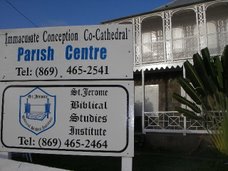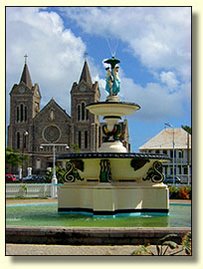In the months of October & Novemebr our parish will be embarking on new effort of new evangelization through the Neo-Catechumenal Way. A priest from the Diocese of Rome Fr. Charels Bell will be conductiong a series of sessions with testimonies and Kerygmatic preaching on Sundays and Tuesdays (6.00-700 pm) of October and November. All the initial sessions will be held in the Immaculate Conception Co-Cathedral. It is hoped that after those initial sessions a community will be established embarking on a journey of a systematic Catholic Formation.
All intersted persons are cordially invited!!!
Bleow there is some history of the Neocatechumenal Way:
1. The beginning: a theological –– catechetical synthesis
At the beginning of the Sixties, Kiko Argüello, a Spanish painter, after experiencing an existential crisis, discovered in the suffering of the innocent people the awesome mystery of the crucified Christ which is present in the ‘‘least’’ of the earth. Such a discovery made him abandon all things and following the footsteps of Charles de Foucauld, he went to live among the poor people of the slums of ‘‘ Palomeras Altas’’ in the outskirts of Madrid. It was there that another Spanish woman, Carmen Hernààndez, a graduate in Chemistry, came to know Kiko Argüüello. She had come in touch with the renewal of the Second Vatican Council thanks to Monsignor Farnéés Scherer ( a liturgist) and had been called by her bishop while trying to gather together a group of people with a view to evangelise the miners of Oruro ( Bolivia).
The environment of the slums was one of the most degraded in society, mainly made up of gypsies and ‘‘quinquis’’ (white nomads) as well as illiterate people, tramps, thieves, prostitutes, young delinquents, etc……
Kiko’’s artistic temperament, his existential experience, his previous formation as a catechist of the ‘‘Cursillos de Christianidad’’, Carmen’’s thrust for evangelisation –– formed in the Institute of the ‘‘Misioneras de Cristo Jesùùs’’- her theological preparation ( she has a licence in theology), her knowledge of the Paschal Mystery and the Liturgical renewal of the Vatican Council, together with the environment of ‘‘these poorest of the poor’’ of the earth were the elements that created the ‘‘humus’’, ‘‘the lab’’ in which a kerygmatic, theological –– catechetical synthesis came into being. Such synthesis would then become the back bone for the process of evangelisation of adult people later known as the Neocatechumenal Way.
2. For the Church and with the Church.
Faced with this kerygmatic synthesis the poor people of the slums did not defend themselves against it. On the contrary, they responded with immense gratitude and thus constituted a first Christian community. It is this community that gave birth to the first seed, the first ‘‘mustard seed’’ of something that today we can see has become a great tree full of fruits. That ‘‘seed’’ came to the notice of the Archbishop of Madrid, Monsignor Casimiro Morcillo, on the occasion of his visit to the slums. There he could personally witness the action of the Holy Spirit and consequently defended it, blessed it and identified it as a true realisation of the Council –– he had been, in fact, one of the General Secretaries of the Second Vatican Council. He then sent this seed to the parishes of Madrid with the recommendation that the parish priest should always be at its centre. At the same time he approved ‘‘ad experimentum’’ some necessary liturgical adaptations for a Christian initiation: the Word, the Liturgy and the Community.
3. From the slums to the parishes.
The Way which was born in the midst of so much suffering and among the poorest was brought to the parishes thanks to Don Casimiro Morcillo. The first parish to receive it was of an upper ––middle class type. It was there that Kiko, Carmen and some poor brothers from the slums were invited to speak about the Eucharist. In fact the parish priest of that parish had been greatly impressed by the power of the liturgy he had experienced in the slums. Later on, they were invited to Zamorra, a rural parish made up mostly of farmers and very religious people. Returning to Madrid, they had two more experiences: one in the parish of Pius XII among upper class people and the second at Canillejas, a dormitory like neighbourhood in the outskirts of the city and later in many other parishes
4. An itinerary appears.
The challenge faced by this catechetical synthesis brought by the group from the slums of Madrid soon revealed a particular tendency when coming in touch with parishes: the catecheses tended to be ‘‘dressed up’’ and transformed into conferences. Such conferences would enlighten the mind, enrich the culture but ultimately could not be understood as a way of self –– emptying, a kenosis whereby the old man is slowly brought to die in order to be filled by a new creation in the Holy Spirit. The social situation was already so serious that the necessity of an adult Christian became clearer and clearer: a Christian capable to respond to the signs of the time. In this way the renewal of Baptism appeared as an itinerary, a Way which fundamentally would lead to an adult faith capable of giving an answer to the epochal change that was taking place.
In the parishes many people who received the sacraments were insufficiently catechised and mostly ignorant of the contents of Baptism. By opening a way of Christian initiation such people would find, in a Post-Baptismal itinerary of a catechumenal type, the possibility to recovering the stages of Baptism already received as infants.
With respect to the neocatechumenal process, its fundamental stages, its permanent formation, a catechumenate for the non-baptised and service for catechetical activity, refer to the respective headings as found in he Statutes.
To Know more check: http://www.camminoneocatecumenale.it/en/index.asp
Friday, September 21, 2007
Subscribe to:
Posts (Atom)






